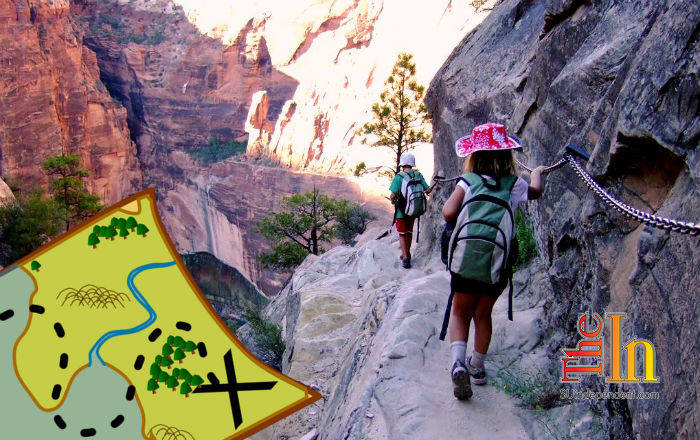 Article and photos by Bo Beck and Tanya Milligan
Article and photos by Bo Beck and Tanya Milligan
CLOSURE NOTICE: Unfortunately, since this was first reported on this trail has since been closed… Weeping Rock and the lower East Rim Trail/Observation Point Trail are currently closed due to a massive landslide. (On August 24, 2019, a large rockfall off of the face of Cable Mountain buried the Weeping Rock pantheon in sand and rubble. The trail was previously closed from a smaller landslide that blocked the trail in January 2019 as well as several landslides that blocked the Hidden Canyon spur trail in July 2018.) Sadly, Hidden Canyon may be closed for the foreseeable future.
Day hike: Yes
Trail distance: 2.2 miles round-trip to the canyon entrance, but most will venture another 0.25 miles into Hidden Canyon.
Average hiking time: 3–4 hours depending on how far you choose to travel past progressively difficult obstacles. Be careful to only explore as far as you know is safe for you! Few should ever venture past the freestanding arch.
Difficulty: This is a busy and strenuous uphill hike on a well-maintained trail. There are numerous switchbacks on a narrow cliffside with exposure at high elevations. Some parts have chains to use for assistance. Be cautious near slippery sandstone areas with steep drop-offs.
Sun exposure: Expect full sun in most places after the early morning hours pass. It will be quite hot if you attempt this trail in the middle part of a summer day; however, once you are into the canyon, it is shady and surprisingly cool.
Trailhead: Weeping Rock parking lot
Trailend: Same as trailhead
Best season: March to October, but the path may be impassible when ice accumulates on the rock walkway in the winter. Zion National Park’s shuttles do not run in the winter, but you can drive into the canyon when they are not operating.
Elevation gain: 1,000-foot ascent
Restrooms: Weeping Rock Trailhead
Water availability: Although short, this hike is steep and in full sun, so do not go without at least three quarts of water per person.
Hidden Canyon is one of Zion National Park’s unique trails that challenges the average hiker with steep ascents and narrow chain-aided foot paths.
The classic Zion Canyon Trail was developed in 1928, a year after the “hanging canyon” — dubbed “Hidden Canyon” — was discovered. William Evans tried to climb the Great White Throne in 1927 but fell during the attempt. While searching for the climber, who was miraculously found alive, rescuers discovered a secluded oasis. Today, a well-traveled path takes trekkers between sheer sandstone walls rising up hundreds of feet, made up by some of Zion’s most famous landmarks: Cable Mountain and the Great White Throne. Once beyond the end of the actual trail and into the slot canyon, look for small sandstone caves and a 20-foot long arch. The structure sits at ground level but is missed by most, due to the greenery on and near the natural structure that allows it to blend in as a chameleon would with its background.



